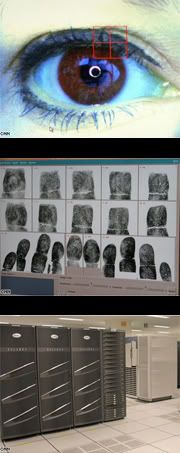FBI Wants Palm Prints, Eye Scans, Tattoo Mapping
 Kelli Arena and Carol Cratty
Kelli Arena and Carol Cratty
CNN
February 4, 2008
CLARKSBURG, West Virginia (CNN) -- The FBI is gearing up to create a massive computer database of people's physical characteristics, all part of an effort the bureau says to better identify criminals and terrorists.
But it's an issue that raises major privacy concerns -- what one civil liberties expert says should concern all Americans.
The bureau is expected to announce in coming days the awarding of a $1 billion, 10-year contract to help create the database that will compile an array of biometric information -- from palm prints to eye scans.
Kimberly Del Greco, the FBI's Biometric Services section chief, said adding to the database is "important to protect the borders to keep the terrorists out, protect our citizens, our neighbors, our children so they can have good jobs, and have a safe country to live in."
But it's unnerving to privacy experts.
"It's the beginning of the surveillance society where you can be tracked anywhere, any time and all your movements, and eventually all your activities will be tracked and noted and correlated," said Barry Steinhardt, director of the American Civil Liberties Union's Technology and Liberty Project.
The FBI already has 55 million sets of fingerprints on file. In coming years, the bureau wants to compare palm prints, scars and tattoos, iris eye patterns, and facial shapes. The idea is to combine various pieces of biometric information to positively identify a potential suspect.
A lot will depend on how quickly technology is perfected, according to Thomas Bush, the FBI official in charge of the Clarksburg, West Virginia, facility where the FBI houses its current fingerprint database.
"Fingerprints will still be the big player," Bush, assistant director of the FBI's Criminal Justice Information Services Division, told CNN.
But he added, "Whatever the biometric that comes down the road, we need to be able to plug that in and play."
First up, he said, are palm prints. The FBI has already begun collecting images and hopes to soon use these as an additional means of making identifications. Countries that are already using such images find 20 percent of their positive matches come from latent palm prints left at crime scenes, the FBI's Bush said.
The FBI has also started collecting mug shots and pictures of scars and tattoos. These images are being stored for now as the technology is fine-tuned. All of the FBI's biometric data is stored on computers 30-feet underground in the Clarksburg facility.
In addition, the FBI could soon start comparing people's eyes -- specifically the iris, or the colored part of an eye -- as part of its new biometrics program called Next Generation Identification.
Nearby, at West Virginia University's Center for Identification Technology Research, researchers are already testing some of these technologies that will ultimately be used by the FBI.
"The best increase in accuracy will come from fusing different biometrics together," said Bojan Cukic, the co-director of the center.
But while law enforcement officials are excited about the possibilities of these new technologies, privacy advocates are upset the FBI will be collecting so much personal information.
"People who don't think mistakes are going to be made I don't think fly enough," said Steinhardt.
He said thousands of mistakes have been made with the use of the so-called no-fly lists at airports -- and that giving law enforcement widespread data collection techniques should cause major privacy alarms.
"There are real consequences to people," Steinhardt said.
You don't have to be a criminal or a terrorist to be checked against the database. More than 55 percent of the checks the FBI runs involve criminal background checks for people applying for sensitive jobs in government or jobs working with vulnerable people such as children and the elderly, according to the FBI.
The FBI says it hasn't been saving the fingerprints for those checks, but that may change. The FBI plans a so-called "rap-back" service in which an employer could ask the FBI to keep the prints for an employee on file and let the employer know if the person ever has a brush with the law. The FBI says it will first have to clear hurdles with state privacy laws, and people would have to sign waivers allowing their information to be kept.
Critics say people are being forced to give up too much personal information. But Lawrence Hornak, the co-director of the research center at West Virginia University, said it could actually enhance people's privacy.
"It allows you to project your identity as being you," said Hornak. "And it allows people to avoid identity theft, things of that nature."
There remains the question of how reliable these new biometric technologies will be. A 2006 German study looking at facial recognition in a crowded train station found successful matches could be made 60 percent of the time during the day. But when lighting conditions worsened at night, the results shrank to a success rate of 10 to 20 percent.
As work on these technologies continues, researchers are quick to admit what's proven to be the most accurate so far. "Iris technology is perceived today, together with fingerprints, to be the most accurate," said Cukic.
But in the future all kinds of methods may be employed. Some researchers are looking at the way people walk as a possible additional means of identification.
The FBI says it will protect all this personal data and only collect information on criminals and those seeking sensitive jobs.
The ACLU's Steinhardt doesn't believe it will stop there.
"This had started out being a program to track or identify criminals," he said. "Now we're talking about large swaths of the population -- workers, volunteers in youth programs. Eventually, it's going to be everybody."












No comments:
Post a Comment